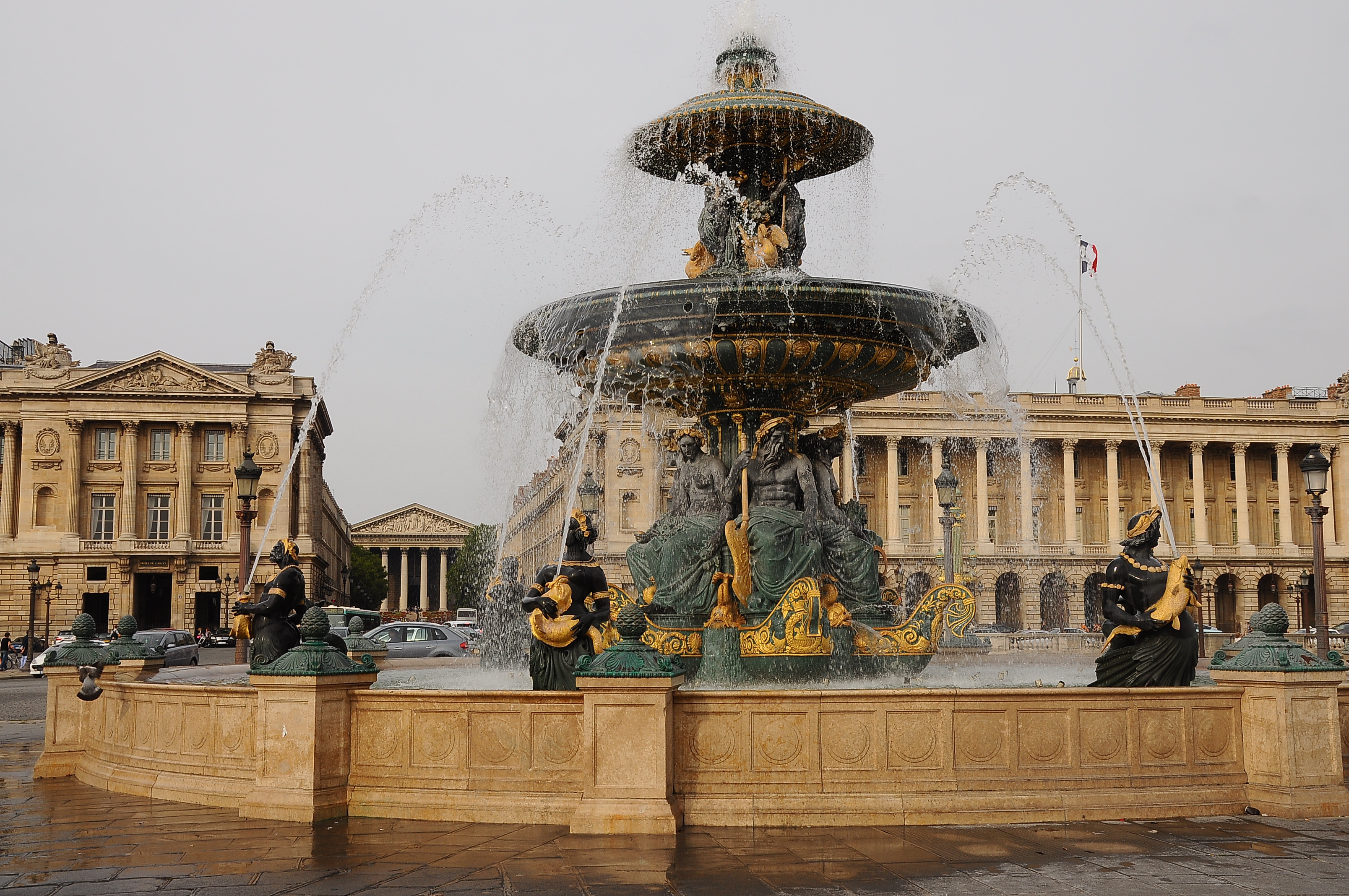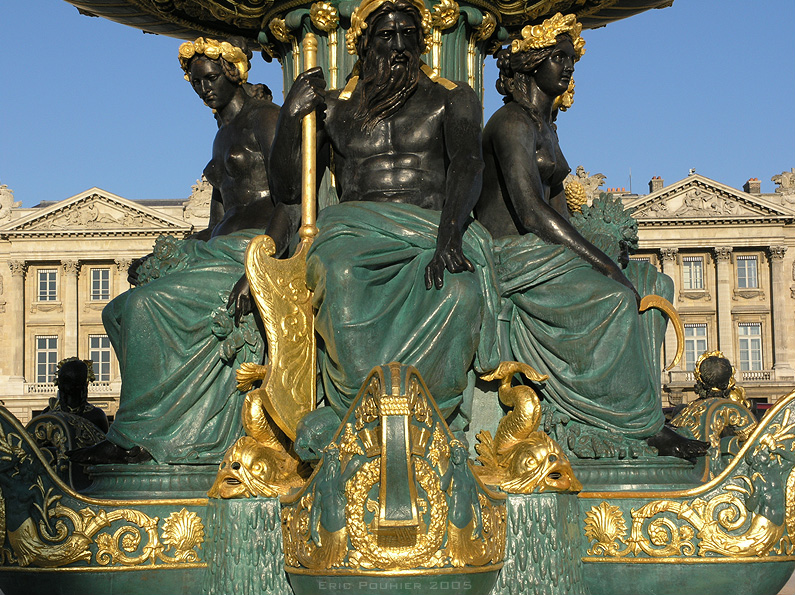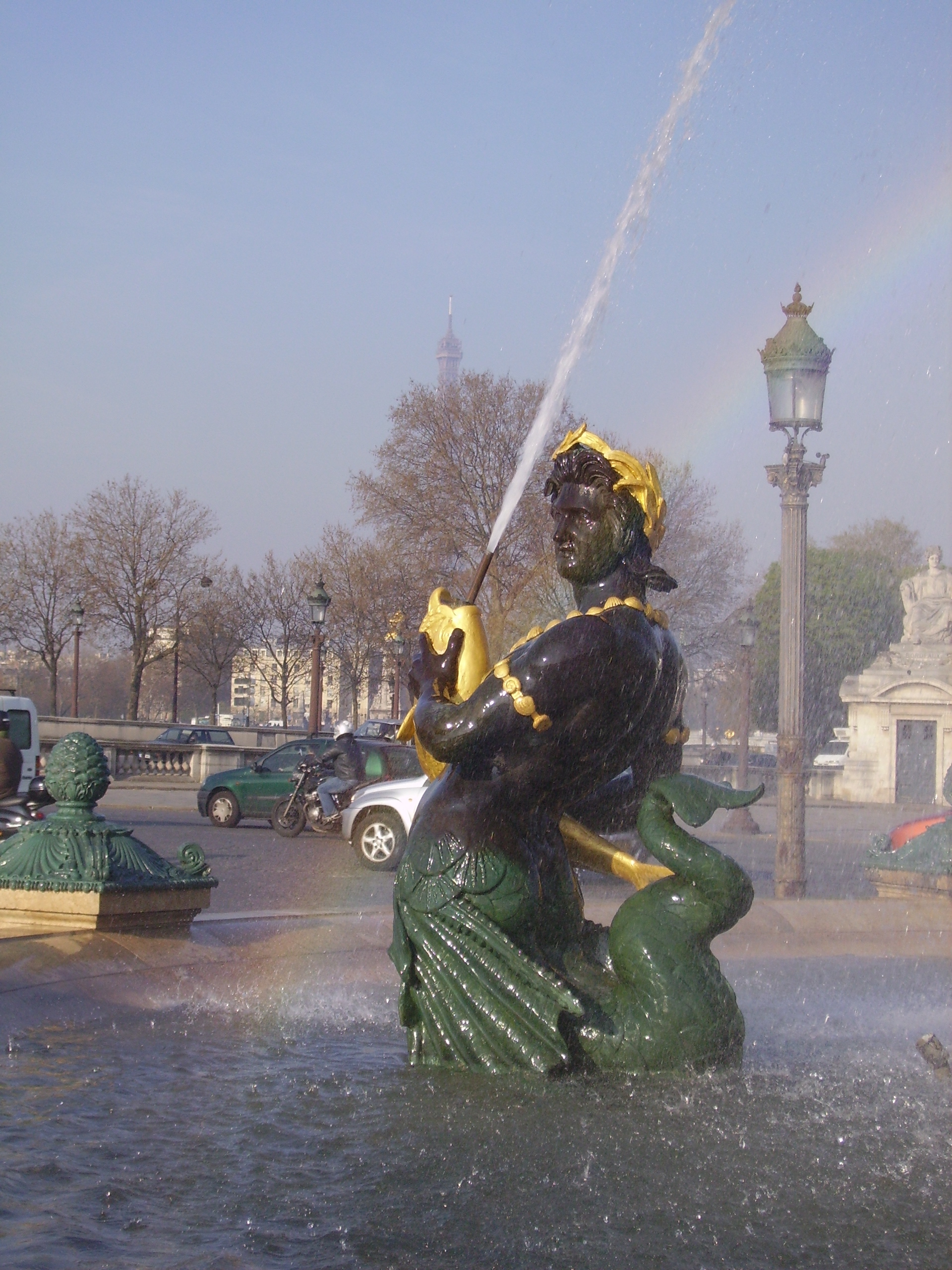Fontaines de la Concorde on:
[Wikipedia]
[Google]
[Amazon]





 The Fontaines de la Concorde are two monumental fountains located in the
The Fontaines de la Concorde are two monumental fountains located in the





 The Fontaines de la Concorde are two monumental fountains located in the
The Fontaines de la Concorde are two monumental fountains located in the Place de la Concorde
The Place de la Concorde () is one of the major public squares in Paris, France. Measuring in area, it is the largest square in the French capital. It is located in the city's eighth arrondissement, at the eastern end of the Champs-Élysées. ...
in the center of Paris
Paris () is the capital and most populous city of France, with an estimated population of 2,165,423 residents in 2019 in an area of more than 105 km² (41 sq mi), making it the 30th most densely populated city in the world in 2020. Si ...
. They were designed by Jacques Ignace Hittorff
Jacques Ignace Hittorff or, in German, Jakob Ignaz Hittorff (, ) ( Cologne, 20 August 1792 – 25 March 1867) was a German-born French architect who combined advanced structural use of new materials, notably cast iron, with conservative Bea ...
, and completed in 1840 during the reign of King Louis-Philippe
Louis Philippe (6 October 1773 – 26 August 1850) was King of the French from 1830 to 1848, and the penultimate monarch of France.
As Louis Philippe, Duke of Chartres, he distinguished himself commanding troops during the Revolutionary Wa ...
. The south fountain commemorates the maritime commerce and industry of France, and the north fountain commemorates navigation and commerce on the rivers of France.
History
Before theFrench Revolution
The French Revolution ( ) was a period of radical political and societal change in France that began with the Estates General of 1789 and ended with the formation of the French Consulate in November 1799. Many of its ideas are conside ...
, during the period 1753–1772, when the square was called Place Louis XV
Louis XV (15 February 1710 – 10 May 1774), known as Louis the Beloved (french: le Bien-Aimé), was King of France from 1 September 1715 until his death in 1774. He succeeded his great-grandfather Louis XIV at the age of five. Until he reache ...
, the architect Jacques-Ange Gabriel designed a plan for a monumental statue of Louis XV with two fountains, but because of a lack of sufficient water, it was never carried out. Gabriel did complete the building of the Ministry of the Navy overlooking the square - its presence later influenced the choice of themes for the Fontaines de la Concorde.
During the French Revolution, the square was renamed Place de la Revolution, the guillotine was placed there, and King Louis XVI
Louis XVI (''Louis-Auguste''; ; 23 August 175421 January 1793) was the last King of France before the fall of the monarchy during the French Revolution. He was referred to as ''Citizen Louis Capet'' during the four months just before he was ...
and thousands of others were beheaded near the site of the present fountains. In 1795, after the Reign of Terror
The Reign of Terror (french: link=no, la Terreur) was a period of the French Revolution when, following the creation of the First French Republic, First Republic, a series of massacres and numerous public Capital punishment, executions took pl ...
ended, the square was renamed the Place de la Concorde. After the restoration of the Monarchy in 1816 the square was renamed in the Memory of King Louis XVI.
The completion of the Canal de l'Ourcq in 1824, bringing water from outside the city to the Center of Paris, made it possible to build new fountains in the Place de la Concorde. In 1829, during the rule of King Charles X, the city sponsored a competition for a new plan for the square, which was to include no less than four fountains. One of the entrants in the competition was Jacques Ignace Hittorff
Jacques Ignace Hittorff or, in German, Jakob Ignaz Hittorff (, ) ( Cologne, 20 August 1792 – 25 March 1867) was a German-born French architect who combined advanced structural use of new materials, notably cast iron, with conservative Bea ...
, a German by birth, who had previously designed decorations for festivals, funerals, and the 1825 coronation of Charles X. The plan of Hittorff featured four fountains in four quadrants surrounding an equestrian statue of Louis XVI. His plan was not selected.
After the 1830 July Revolution, the new King, Louis-Philippe, renamed the square Place de la Concorde and rejected the earlier project for the Place. In 1831, when the viceroy of Egypt, Mohammed Ali
Muhammad Ali (; born Cassius Marcellus Clay Jr.; January 17, 1942 – June 3, 2016) was an American professional boxer and activist. Nicknamed "The Greatest", he is regarded as one of the most significant sports figures of the 20th century, ...
, gave the King the gift of an obelisk
An obelisk (; from grc, ὀβελίσκος ; diminutive of ''obelos'', " spit, nail, pointed pillar") is a tall, four-sided, narrow tapering monument which ends in a pyramid-like shape or pyramidion at the top. Originally constructed by An ...
dating from the time of Ramses II
Ramesses II ( egy, rꜥ-ms-sw ''Rīʿa-məsī-sū'', , meaning "Ra is the one who bore him"; ), commonly known as Ramesses the Great, was the third pharaoh of the Nineteenth Dynasty of Egypt. Along with Thutmose III he is often regarded as t ...
from Luxor
Luxor ( ar, الأقصر, al-ʾuqṣur, lit=the palaces) is a modern city in Upper (southern) Egypt which includes the site of the Ancient Egyptian city of ''Thebes''.
Luxor has frequently been characterized as the "world's greatest open-a ...
, Louis-Philippe selected Hittorff to design a setting for the obelisk in time for the 1833 July festival, intended to commemorate the anniversary of his rule. Shortly afterwards Louis-Philippe gave him a commission to redesign the entire square.
Hittorff worked on the design for the square and for four fountains from 1833 to 1840, consulting closely with Claude Philibert Barthelot Rambuteau, the Prefect of the Seine. The principal influence on his fountain designs were the twin fountains in Piazza San Pietro in Rome, which also are placed on either side on an obelisk, and which Hittdorff had seen on a visit to Rome in the 1820s. Another influence was Piazza Navona in Rome, where two fountains were placed on either side of an obelisk. Like the fountains of Piazza Navona, the Fontaines de la Concorde were placed on an axis that connected the Church of the Madeleine and the Rue Royale to the north and the bridge to the Palais Bourbon
The Palais Bourbon () is the meeting place of the National Assembly, the lower legislative chamber of the French Parliament. It is located in the 7th arrondissement of Paris, on the '' Rive Gauche'' of the Seine, across from the Place de la Con ...
to the south.
Twelve different sculptors worked on the statuary of the fountains, closely supervised by Hittorff, who made sure that the entire ensemble would be harmonious and balanced.
A prominent feature of the design of both fountains was a mushroom-shaped cap above the central vasque. Water was to jet from the top of the cap and then cascade downward into a circular vasque, then down into a large circular basin below. The major figures of the fountains were made of cast iron, florentined, or painted with bronze and gold paint. The smaller figures of the tritons and nereid
In Greek mythology, the Nereids or Nereides ( ; grc, Νηρηΐδες, Nērēḯdes; , also Νημερτές) are sea nymphs (female spirits of sea waters), the 50 daughters of the ' Old Man of the Sea' Nereus and the Oceanid Doris, sisters ...
s were made of bronze.
Between 1833 and 1840, Hittdorff modified the plans several times. In 1835, when a government committee reported that the water supply would not be sufficient for four new fountains, he reduced the number to two. The obelisk was put in place on the square on October 25, 1836. Both fountains were completed in May, 1840.
In 1862–63, the fountains were restored, and the bronze and gold paint was replaced with a bronze coating.
Sculptors
The sculptors who worked on the fountain were: * Auguste-Hyacinthe Debay (The Atlantic and the Mediterranean) *Antoine Desboeufs (Coral and Fish) * Achille-Joseph-Étienne Valois (Shells and Pearls) *Isidore-Hippolyte Brion (Maritime navigation, Astronomy and Commerce) * Jean-François-Théodore Gechter (The Rhône and the Rhine) *François-Gaspard Lanno (Flowers and Fruit) *Honoré-Jean Husson (Wheat and Grapes) *Jean-Jacques Feuchère
Jean-Jacques Feuchère (24 August 1807 – 26 July 1852) was a French sculptor.
He was a student of Jean-Pierre Cortot, and among his students was Jacques-Léonard Maillet.
Selected works
* Relief panel ''Le Pont d'Arcole'', Arc de Triomp ...
(River Navigation, Industry and Agriculture)
*Jean-Jacques Elshoecht, Louis-Parfait Merlieux, Antonin-Marie Moine (tritons and neriads).
Symbolism
The Maritime Fountain, to the south, closer to the River Seine, represents the maritime spirit of France. Large semi-nude figures supporting the vasque represent theMediterranean Sea
The Mediterranean Sea is a sea connected to the Atlantic Ocean, surrounded by the Mediterranean Basin and almost completely enclosed by land: on the north by Western and Southern Europe and Anatolia, on the south by North Africa, and on ...
and the Atlantic Ocean
The Atlantic Ocean is the second-largest of the world's five oceans, with an area of about . It covers approximately 20% of Earth's surface and about 29% of its water surface area. It is known to separate the " Old World" of Africa, Europe ...
. Other figures beneath the vasque represent the industries of the sea; coral
Corals are marine invertebrates within the class Anthozoa of the phylum Cnidaria. They typically form compact colonies of many identical individual polyps. Coral species include the important reef builders that inhabit tropical oceans and se ...
, fish
Fish are Aquatic animal, aquatic, craniate, gill-bearing animals that lack Limb (anatomy), limbs with Digit (anatomy), digits. Included in this definition are the living hagfish, lampreys, and Chondrichthyes, cartilaginous and bony fish as we ...
, shells and pearls
A pearl is a hard, glistening object produced within the soft tissue (specifically the mantle) of a living shelled mollusk or another animal, such as fossil conulariids. Just like the shell of a mollusk, a pearl is composed of calcium carb ...
.
The figures are seated in the prow of a ship, the symbol of the City of Paris, and they are surrounded by dolphins spraying water through their nostrils.
Above the vasque, supporting the mushroom-shaped cap, are figures representing the spirits of Maritime Navigation, Astronomy and Commerce. Next to them are swans which spout water into the basin below.
In the basin, tritons and nereids
In Greek mythology, the Nereids or Nereides ( ; grc, Νηρηΐδες, Nērēḯdes; , also Νημερτές) are sea nymphs (female spirits of sea waters), the 50 daughters of the ' Old Man of the Sea' Nereus and the Oceanid Doris, sisters ...
hold fish which spout water upwards to the rim of the vasque.
The Fountain of the Rivers, to the north, closer to the Madeleine church, has large figures supporting the vasque who represent the Rhône River
The Rhône ( , ; wae, Rotten ; frp, Rôno ; oc, Ròse ) is a major river in France and Switzerland, rising in the Alps and flowing west and south through Lake Geneva and southeastern France before discharging into the Mediterranean Sea. At Ar ...
and the Rhine River
), Surselva, Graubünden, Switzerland
, source1_coordinates=
, source1_elevation =
, source2 = Rein Posteriur/Hinterrhein
, source2_location = Paradies Glacier, Graubünden, Switzerland
, source2_coordinates=
, source ...
. The other major figures represent the main harvests of France; Wheat and Grapes, Flowers and Fruit.
The figures above the vasque who support the cap represent the spirits of River Navigation, Agriculture and Industry.
Water supply and the fountain design
Water for the fountains was supplied by the canal de l'Ourcq, begun by Napoleon at the beginning of his reign. The original fountains had no pumps and operated by gravity- water flowed from the basin at La Villette, where the water of the canal arrived in Paris, at a higher elevation than the Place de la Concorde. The overflow water went into the Seine. Beginning in 1840, 6,000 cubic meters of water per day from La Villette were set aside for the Fontaines de la Concorde. The fountains were carefully designed so that a sheet of water flowed evenly from the rim of the vasque, even if the wind was strong and the water supply was uneven. A small channel hidden just inside the rim of the vasque moderates the flow of water.Schneider, pg. 400 In the 20th century, the gravity system was replaced with pumps, which recycle the water.Sources and citations
Bibliography
* *Marilyn Symmes (editor), ''Fountains - Splash and Spectacle - Water and Design from the Renaissance to the Present''. Thames and Hudson, in association with Cooper Hewitt National Design Museum, Smithsonian Institution, 1998 *Beatrice de Andia (editor), ''Paris et ses Fontaines, de la Renaissance a nos jours'', Collection Paris et son Patrimoine, Paris, 1995 *Schneider, Donald, ''The Works and Doctrine of Jacques Ignace Hittorff'' (1792–1867), 2 vols. New York, 1977. Fountains in Paris Buildings and structures in the 8th arrondissement of ParisExternal links
{{Commonscat, Fountains in the Place de la Concorde